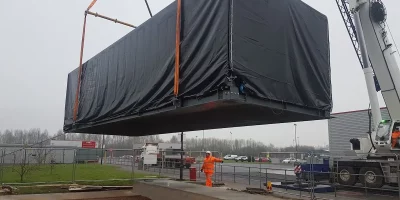A containerized data center concept is unique, innovative, challenging, and beneficial. It allows for a well-organized and secure IT infrastructure that is easily accessible. Over time, the popularity of container data centers has increased significantly, leading providers to offer various cooling system options, sizes, spaces, and layouts.
To put it simply, containerization provides a modular solution even for companies that need more skilled IT staff to maintain their systems. In addition, it comes with pre-made units that can be easily set up without needing any employees, making it a cost-effective alternative for brands lacking human labor.
What Is a Containerized Data Center?
A containerized server room or data center is a shipping container designed to house IT equipment such as servers, storage devices, networking gear, uninterruptible power supplies, generators, and cooling equipment.
You can also deploy separate containers for power and cooling equipment alongside a containerized data center. The container usually has built-in connectivity for accessing external power, water (for cooling purposes), and data.
Benefits of Choosing a Containerized Data Center?
Free Up Space
Transferring your IT infrastructure to a container will free up significant space inside your building. This means you won’t need to dedicate a large area to constructing a data center. As a result, you can use your valuable square footage to create additional office space.
Easy to Deploy
In addition to their energy efficiency and providing extra space, containerized data centers are easy to maintain. They are designed to be weather-resistant; therefore, you do not have to be concerned about any damage. You can put them outside of your company premises or in underused spaces.
Secondly, containers may seem massive, but they take up less space because they can be stacked without toppling. Access doors on both sides also allow easy entry to each container.
Faster Scalability
Scalability is crucial for running a company smoothly. Containerized data centers offer a convenient way to achieve scalability.
Made Energy Efficient
The most notable benefit is the energy-saving feature. The products are designed to be energy-efficient, which improves cooling efficiency and helps you save on ongoing operational costs. The modular design of this system includes integrated power and cooling equipment, which helps to reduce infrastructure expenses and shorten installation time. It is unique in its design.
Difference Between Modular and Containerized Data Centers
What is the advantage of using modular or containerized systems? First, both options offer a consistent package for gradually expanding a data center as needed. This means a facility can start with a basic amount of power and add progressively more racks, cooling, and support equipment over time. Then, as the company gains more customers or expands, additional servers and networking equipment are installed to meet the increased demand.
Containerized data centers
These units, also known as pods depending on the vendor or marketing term, are delivered in a shipping container or similarly sized structure. They work well for temporary deployments, such as in a disaster area. If a company’s data centers are complete but need more time to transition to cloud services, containers’ modular approach can provide a valuable solution for adding more servers. However, the reverse is not necessarily true, while containers can be modular.
Modular data centers
They all have similar benefits but with different levels of pre-made components. Additionally, they allow for easy maintenance and compatibility with a broader range of hardware. For example, a modular design comprises racks arranged in a hot/cold aisle without internal cooling or power systems. Instead, external cooling and power systems are used, and the access control method includes a network connection. Based on the specific implementation, additional components can be easily incorporated using pre-packaged modules, such as complete racks.
When the power capacity is insufficient, pre-made power systems that consist of UPS, transformers, switchboards, rectifiers, utility power out, and transfer switches can be installed. Additionally, cooling systems that come in combinations of chillers, condensers, pumps, air handlers, and plumbing can also be prefabricated.
Why Choose a Containerized Data Center?
Using containerized data centers can offer numerous benefits for some or all of your requirements.
Free up space
Deploying a containerized data center can help you reclaim space inside your building. In addition, these data centers are weather resistant and can be set up outside or in underutilized areas of manufacturing facilities like parking garages.
Access doors are typically included on both ends of these containers, allowing multiple containers to be stacked or placed next to each other.
Designed to be energy efficient
Container data centers are built to be highly energy efficient. This reduces ongoing operational costs and minimizes infrastructure expenses and installation timeframes. In addition, with a modular design and integrated power and cooling systems, these container data centers are designed to be highly efficient from the ground up.
Rapid deployment
Using containerized data centers can rapidly increase your existing network and capacity without opening a conventional expansion, which may cost more.
Conclusion
The digital economy’s growth has spurred the rapid development of industries such as cloud computing, the Internet of Things, and big data. As a result, data centers are facing increasingly demanding requirements. As a result, the limitations of traditional data centers have become more evident and need to be revised to fulfill market demands. Prefabricated containerized data centers meet current market needs and will experience rapid growth.
Although they have some drawbacks, containerized data centers offer clear benefits over traditional data centers. Based on significant cost savings in immediate short-term investments and future long-term operating costs, containerized data centers are now becoming the preferred method for constructing data centers.






